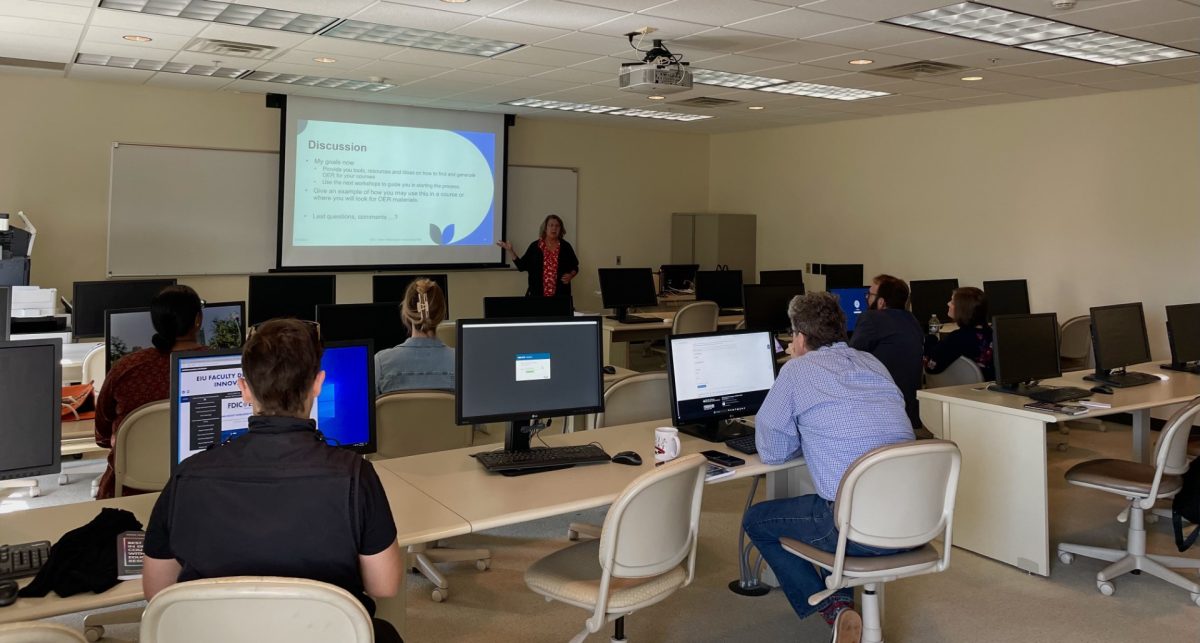On Tuesday, Sept. 19, an Open Educational Resource workgroup gathered six attendees and facilitator Dr. Lauri DeRuiter-Willems.
The workgroup met from 9 a.m. to 10 a.m. and discussed the importance of Open Educational Resources (OER) for education. All the attendees were currently in the work field surrounding education, which allowed the meeting to be very crucial for them.
When the meeting officially started, everybody gave an introduction, discussing their experience with OER.
They were also instructed to talk about issues regarding textbooks. They were asked to explain one good thing about textbook rentals and one good thing about purchasing a textbook. After that, they were asked to voice how textbook rentals or purchased textbooks could improve.
Some opinions expressed included how it can sometimes be beneficial to have a hard copy of the text in front of the student, since they can highlight and annotate in textbooks that they personally own.
Whereas textbook rentals forbid you from writing, highlighting, or removing pages from the text. If the textbook is suspected to contain any of those forbidden factors, the student risks paying the full price.
Even though textbook rentals cut the cost for students when receiving textbooks required for a class, a student might not even use the textbook for the semester, which allows the cost of the rental textbook fee to add up.
To improve the use of textbooks, the meeting members agreed that the system for receiving a textbook should be updated, but it would need to be modified into a new way students gain information.
Facilitator, Dr. Lauri DeRuiter-Willems, had a presentation slide telling what OER is. She used a definition by Steve Brantley, who defined the practice on his LibGuide, stating, “Open Educational Resources are teaching, learning, and research materials in any format that reside in the public domain or have been released with an open license that permits access, use, repurposing, and/ or redistributing by others with limited or no restrictions.”
Many teachers have been using OER in their lessons without realizing what they were doing. Open Educational Resources are delivery methods, learning outcomes and assessment measures that innovate a classroom in a well-updated and ‘get-to-the-point’ manner.
College students can identify OER in the pursuit of more accessible and affordable learning opportunities while providing quality learning experiences.
Dr. DeRuiter-Willems also presented the benefits OER has for students. The cost is a main attention-getter for OER because of the amount it saves for students.
Students have also improved grades and reduced any chances of withdrawing from a class. The OER program can have multiple positive effects on a person’s life.
“I think OER has made me very aware of how important a lot of the information that I share in my classes can fit into everyone’s lives, specifically in my field, because public health hits people everywhere,” DeRuiter-Willems said. “The pandemic really shined a light on what the general public knows and what they don’t know.”
For the faculty at Eastern, this workgroup can help provide tools, resources and ideas on how to find and use OER in their Courses.
“When it comes to faculty involvement, it is essential to connect with FDIC and their subject librarians so that they have other experts to help guide them through OER because it can be overwhelming to do this and how to use the resources correctly,” DeRuiter-Willems said.
Jacob Adcock can be reached at 581-2812 or at jadcock@eiu.edu.

















![[Thumbnail Edition] Senior Foward Macy McGlone, getsw the ball and gets the point during the first half of the game aginst Western Illinois University,, Eastern Illinois University Lost to Western Illinois University Thursday March 6 20205, 78-75 EIU lost making it the end of their season](https://www.dailyeasternnews.com/wp-content/uploads/2025/03/WBB_OVC_03_O-1-e1743361637111-1200x614.jpg)




















































![[Thumbnail] Eastern's Old Main was quiet Thursday morning while educators who had left the office to strike picketed outside.](https://www.dailyeasternnews.com/wp-content/uploads/2025/04/Strike_01_LT_O-800x1200.jpg)




